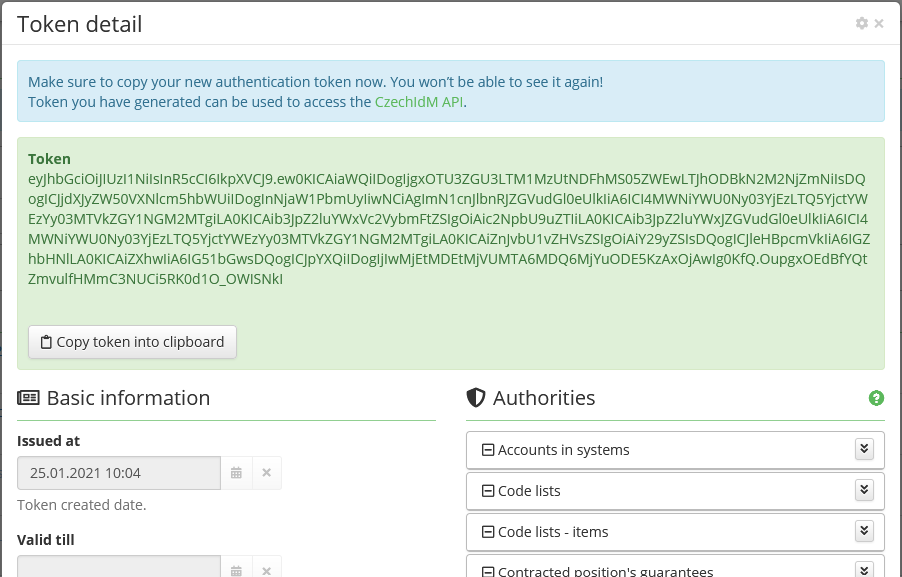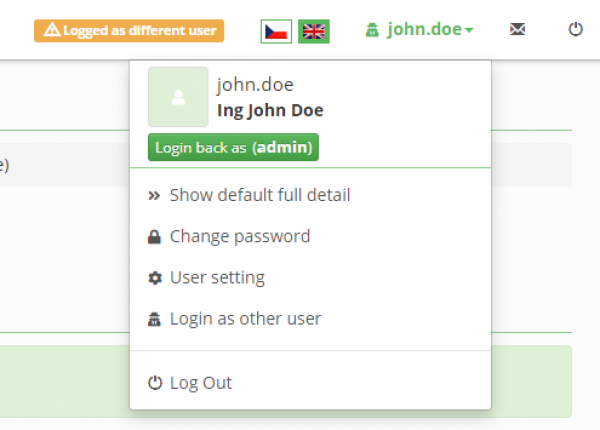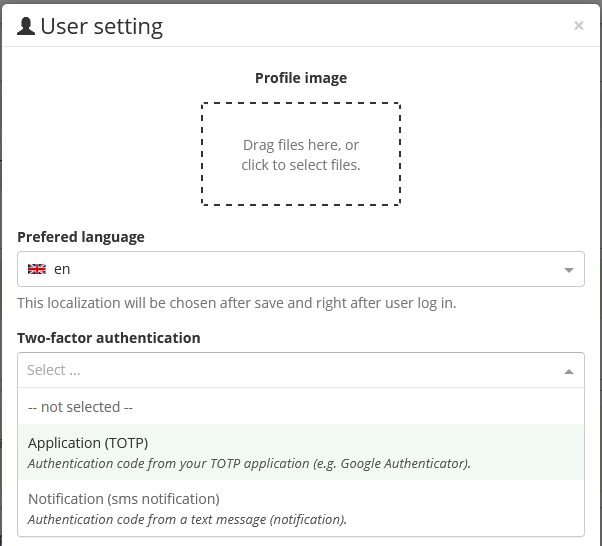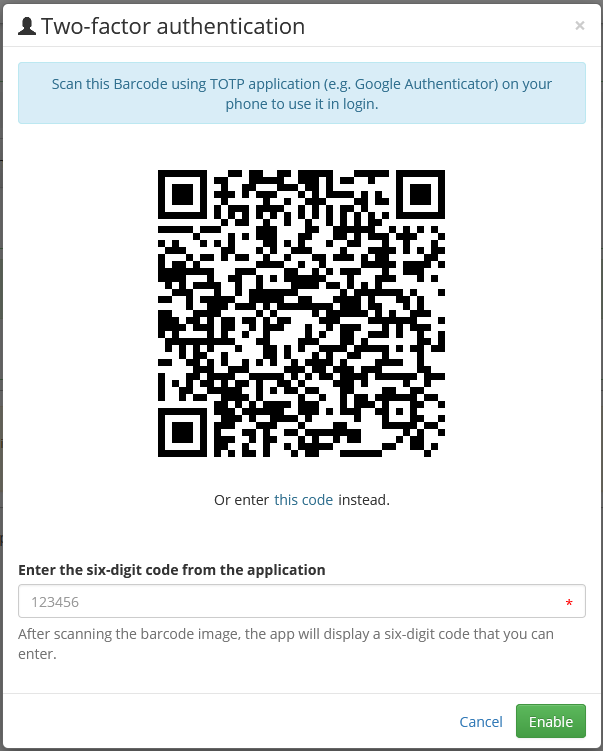Security
Dictionary terms
- Base permission - basic permission, e.g.
READ,CREATE,UPDATE,DELETE - Group permission - group permission could contain base permissions. Group is related to some domain object, e.g.
IDENTITY,ROLE - Authority - Group + base permission, e.g.
IDENTITY\_READ,ROLE\_CREATE. Authority is granted to identity by authentication.
API authentication
API access requires the user to be authenticated, excluding a few public endpoints. We can divide the sign in into two parts:
- authentication - the user proves his identity
- authorization - the user has access to given resource
Authentication
Authentication is implemented through a request filterchain. The filters must always follow specified behavior:
- if credentials are OK, continue to authorization
- if credentials do not match, pass request to another filter in chain
In reality there is only one authentication servlet filter - AuthenticationFilter. Others filters are Spring beans implementing IdmAuthenticationFilter interface. An exception in filters is the ExtendExpirationFilter, which is another servlet filter handling the extension of expiration date of JWT tokens. This filter also controls possible exceptions in authentication flow.
API endpoints
There are 2 endpoints for successful user login:
- /authentication - POST, public - authentication, returns JWT token
- /authentication/remote-auth - GET, secured - authentication against external service, returns JWT token and expects the user to be successfully authenticated by one of filters
And one endpoint for user logout:
- /authentication - DELETE - logout with used JWT token (⇒ disable used JWT token)
In case of successful request on the endpoint, the token is passed in HTTP response header. Respose header is called CIDMST.
Implemented authentication filters
Filter do not check authorization or user's permissions, just validate the request data, transform these and pass them to Authentication Managers. There are following filters in IdM core (the core module):
- BasicIdMAuthenticationFilter
- HTTP Basic authentication, login, and password are base64 encoded in HTTP header "Authorization" prefixed by "Basic ", according to RFC 2617
- internal API transforms the login and password and passes them to Authorization Manager
- enabled by default
- JwtIdMAuthenticationFilter
- validates IdM JWT token (read as "jot")
- tokens without expiration are taken as valid
- HMAC256
- enabled by default
- SsoIdmAuthenticationFilter
- used mainly for AD SSO authentication, expects configured web server in front of IdM which handles Kerberos authentication
- processes the result of the authentication in the HTTP header "REMOTE_USER"
- disabled by default, can be enabled by the configuration property
idm.sec.core.authentication-filter.core-sso-authentication-filter.enabled=true
- external authentication server
- CzechIdM is ready to authenticate users based on external resource
- external filters are based on the same principles mentioned above
- primary purpose is to issue the internal IdM JWT token to user using the remote-auth endpoint
- filter behaves quite permissively - if user accesses other endpoints then those for authentication, the filter signs the user in for each request and completes the request (if the user is authorized)
- CasIdmAuthenticationFilter
- @since 10.9.0
- Used for SSO against CAS
- CAS need to be configured correctly - see tutorial TODO
- By default this filter is disabled
- Don't override this property on FE, otherwise you can end up without option how to login (if CAS is broken). Enable it only directly in application.properties
- Can be enabled by configuration property
idm.pub.core.cas.sso.enabled=true
Authorization and JWT token
User authorization is checked on the API endpoint layer and enforced by Spring Security. The content of IdM JWT:
- currentUsername - effective user's login
- originalUsername - logged user's login
- currentIdentityId - effective user's ID
- originalIdentityId - logged user's ID
- exp - token expiration date
- iat - issued at date
All IdM JWT tokens are signed using HMAC256 algorithm. The symmetric encryption key is configuration property of CzechIdM, stored as "idm.sec.security.jwt.secret.token". Default token expiration time is 10 hours (idm.sec.security.jwt.expirationTimeout). JWT tokens are persisted in database (IdmToken entity) with assigned authorities. When identity is logged out, token is disabled. Disabled and expired tokens are purged periodically by internal scheduled task.
Backend of CzechIdM supports immediate detection of user's authorization change. Each modification type is implemented as application event processor, for further details please check the source code and tests :) When user's authorization changes, then persisted tokens, which user owns, are disabled ⇒ user is logged out. Types of modifications:
- removal of role, which carries application permissions ⇒ user losses some permission.
- disabling the user
- role's permissions change - revokes tokens of all users which have the role assigned
How to use JWT token
Token can be used instead of a basic authentication to authenticate to the CzechIdM API. Token can be obtainted by authentication endpoints above or can be generated from application (token agenda was added @since 10.8.0 version):
Use token agenda for generate system tokens, those can be used for system to system communication. Token expiration can be set optionally, but is not required. Token will grant the same authorities and permissions as token owner.
If you have a valid token, you can use it, for example to get all identities:
curl -X GET "http://localhost:8080/idm-backend/api/v1/identities" -H "accept: */*" -H "CIDMST: eyJhbGciOiJIUzI1NiIsInR5cCI6IkpXVCJ9.ew0KICAiaWQiIDogIjMwNmJlMWMyLTNmZTItNDZlMy1hYzkwLTExZmI1NTA1ZDYwZSIsDQogICJjdXJyZW50VXNlcm5hbWUiIDogImFkbWluIiwNCiAgImN1cnJlbnRJZGVudGl0eUlkIiA6ICJkNDE0YTA5MS0zODE1LTQzOWQtOWVjNi1iZWQ4MTlmZWE0MzkiLA0KICAib3JpZ2luYWxVc2VybmFtZSIgOiAiYWRtaW4iLA0KICAib3JpZ2luYWxJZGVudGl0eUlkIiA6ICJkNDE0YTA5MS0zODE1LTQzOWQtOWVjNi1iZWQ4MTlmZWE0MzkiLA0KICAiZnJvbU1vZHVsZSIgOiAiY29yZSIsDQogICJleHBpcmVkIiA6IGZhbHNlLA0KICAiZXhwIiA6IG51bGwsDQogICJpYXQiIDogIjIwMjEtMDEtMjVUMTA6MDk6NTYuODk1KzAxOjAwIg0KfQ.4duJJb5pJDfJvXmdk259gW92fkjzqEr8ya9VqVJ3jCo"
TokenManager
TokenManager is used for creating IdM tokens. Token can be created for different purpose (token type). When token is used, can be disabled (e.g. logout, one time usage).
Token expiration extension
By default both frontend (FE) and backend (BE) automatically extend the expiration of IdM JWT. In case of successful GET request on API, the token expiration is extended on BE and passed in HTTP response (watch out for CORS, has to be explicitly allowed, since the HTTP header is called "CIDMST"). FE (RestApiService.js) automatically disassembles the response looking for auth. token. If token is present, it is set as new token which shall be used for new API requests (done in App.js). Expiration is extended in one minute window - when token has expiration at least one minute older than new one (prevent to persist token every api call).
Developer tip: do not trust the console, especially while working with promises:
static printHeadersOK(response) {
console.log(response.headers.get('CIDMST')); prints header value
}
static printHeadersWRONG(response) {
console.log(response.headers); // prints '{}', object looks empty
}
Switch user - login as other user
@since 10.5.0
User with authority IDENTITY_SWITCHUSER can login as different user. Feature is usable for checking application behavior under selected user (e.g. helpdesk). Logged user needs to have permission SWITCHUSER to select target user. Feature is available from user main menu in application - any other active user can be selected and currently logged user will be logged as selected used.
Currently logged user token (see above) is filled with selected user authorities - original user is preserved as token owner. Return back (logout) to originally logged user is available from user main menu too.
Enforce password change
@since 10.5.0
When password is reseted (or generated), then password change can be enforced, after the first password usage (after the first user login). User is redirected to password change form and password has to be changed before user can continue to work with application.
SSO
SSO support on FE is implemented by issuing the internal IdM JWT without the need to type in user's credentials. This is done by sending a "prerequest" onto secured /authentication/remote-auth endpoint, accessible only to authenticated users. The authentication itself must be done in one of auth filters.
We expect either HTTP header or Cookie to be the bearer of the remote authentication data. When the user accesses IdM, FE first tries to sign him in using the remote-auth. The remote-auth attempt is done only on first access to CzechIdM, token expiration, authority change or user login.
SSO authentication to AD domain can be configured with the help of SsoIdmAuthenticationFilter and Apache web server, which is installed in front of IdM. For more details about SSO configuration see SSO install guide.
Two-factor authentication
@since 10.7.0
Feature is available from user profile (user main menu) in application. Two-factor authentication is optional and can be enabled from user profile:
After user sign in to CzechIdM using username and password, user will be prompted to provide an authentication code from a text message (notification) or from TOTP application. CzechIdM will only ask to provide two-factor authentication code again if user have logged out, is using a new device, or user session expires.
Supported methods to get authentication code:
* Application - authentication code is generated by TOTP application (Google Authenticator, TOTP Authenticator, FreeOTP etc.). * Sms notification - authentication code is send by standard IdM notification. Sms notifications have to be supported to use this method (sms notification sender needs to be provided).
The first authentication code obtained by selected method is needed to enable using two-factor authentication:
Configuration
Basic configuration is available by application properties.
Advanced: Is possible to change default SHA1 hashing algoritm (~provide different hashing algorithm as spring bean) and default 6-digit verification code length (~change frontend localization) programatically.
CAS authentication
@since 10.9.0
This feature is disabled by default. If you want to enable it, see configuration properties application
You need to have working CAS - You are able to log in directly to CAS. Cas will return username of authenticated user. This username for CAS must be same as username in IdM.
Other then that, you need to configure CAS. Mandatory CAS configuration is below cas.properties
... cas.client.validator-type=CAS30 # ticket is validated multiple times, because auth filter is called multiple times. This should be no security problem, because the token is still usable only for 10 sec. cas.ticket.st.number-of-uses=25 # redirectiong after logout will be supported cas.logout.followServiceRedirects=true ...
idm-200.json
{
"@class" : "org.apereo.cas.services.RegexRegisteredService",
"serviceId" : "https://HOSTNAME/idm.+",
"name" : "IdM",
"id" : 200,
"evaluationOrder" : 1
}
When all configuration is done. You will be able to log into IdM ONLY via CAS. The authentication flow is: Access IdM URL → if you are not logged in → redirect to CAS → log in → redirect back to IdM → You are authenticated in IdM Access IdM URL → If you are logged in (jwt token is valid) → You are authenticated in IdM Logout: Click on logout button in IdM → Log out of IdM → CAS logout URL is called → logout from CAS → redirect to IdM → Redirect back to CAS because you are not authenticated Expired jwt token: Logged out of IdM → redirect to /login → CAS is conntacted → authentication flow is applied now
OIDC authentication
@since 13.1.0
This feature is disabled by default. If you want to enable it, see configuration properties application
CAS Service for OIDC configuration:
idm-oidc-201.json
{
"@class" : "org.apereo.cas.services.OidcRegisteredService",
"clientId" : "client",
"clientSecret": "secret",
"serviceId" : "redirectUrl",
"name" : "CzechIdM OIDC",
"id" : 201,
"evaluationOrder" : 1,
"scopes": ["java.util.HashSet", ["openid"]],
"supportedResponseTypes": ["java.util.HashSet", ["code"]],
"logoutType": "BACK_CHANNEL",
"logoutUrl": "logoutUrl",
"redirectUrl": "redirectUrl"
}
The authentication flow from front

1) User isn't authenticated so frotend redirects user to api endpoint for OIDC login.
2) IDM redirects user to OIDC providers login page (adress from .well-known endpoint on OIDC providers or can be overwritten in config)
3) User login on OIDC providers page
4) User gets redirected back to IDM with "code"
5) IDM uses "code" to get from OIDC provider, ID token and Access token (adress from .well-known endpoint on OIDC providers or can be overwritten in config)
6) After validation IDM creates CIDMST token (with externalID set to SID)
7) IDM redirects to front with CIDMST
The authentication flow from external application (hub, ...)
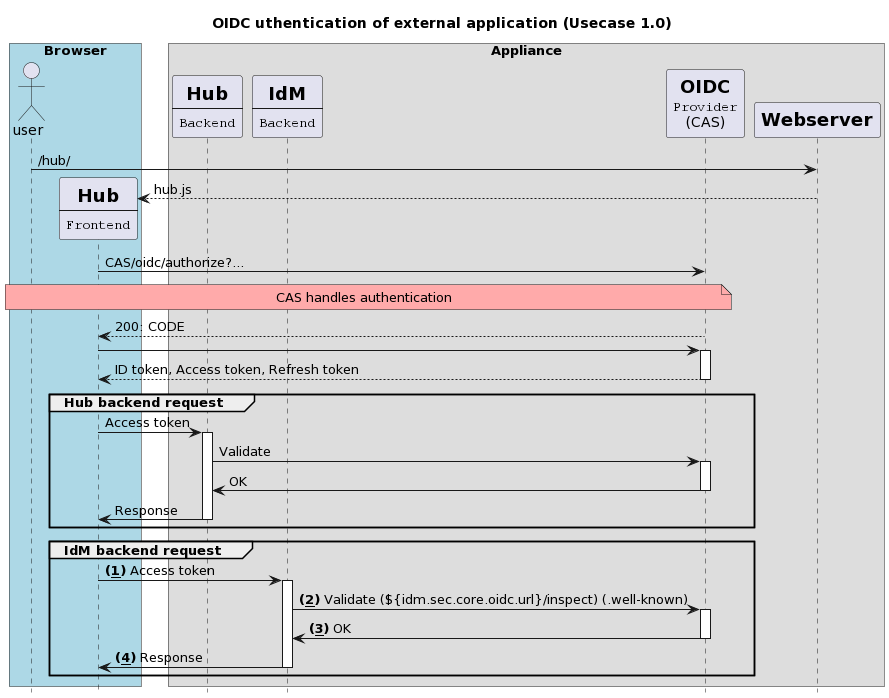
1) Authentication happens on external application
2) When accessing a resource, external application presents access token (in header "Authorization" and value starts with "Bearer") (adress from .well-known endpoint on OIDC providers or can be overwritten in config)
3) IDM validates token on OIDC provider
4) If user has access to resource returns it
Single logout flow from IDM
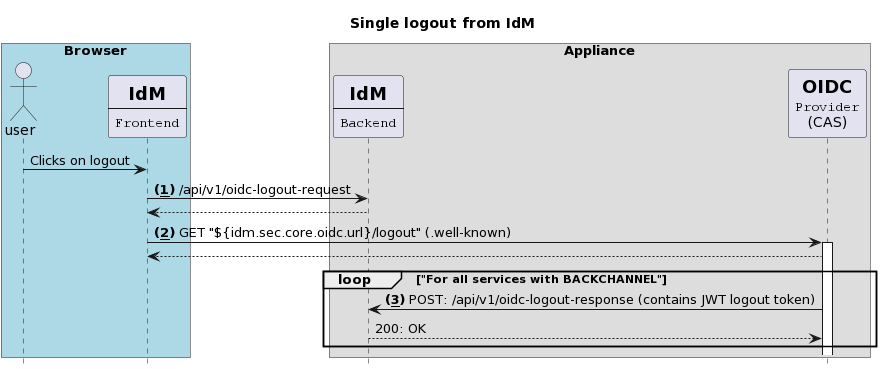
1) User clicks on logout button so front redirects him to api endpoint for OIDC logout.
2) IDM redirect him to logout endpoint on OIDC provider (adress from .well-known endpoint on OIDC providers or can be overwritten in config)
3) OIDC provider calls IMD and IDM invalidates all tokens with SID (from JWT token)
